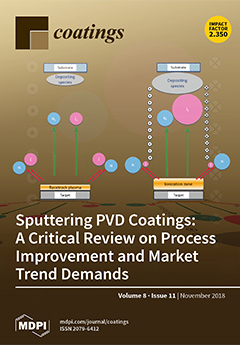Open AccessArticle
Biofilm Formation of a Polymer Brush Coating with Ionic Liquids Compared to a Polymer Brush Coating with a Non-Ionic Liquid
by
Hideyuki Kanematsu, Atsuya Oizumi, Takaya Sato, Toshio Kamijo, Saika Honma, Dana M. Barry, Nobumitsu Hirai, Akiko Ogawa, Takeshi Kogo, Daisuke Kuroda, Katsuhiko Sano, Katsuhiko Tsunashima, Seung-Hyo Lee and Myeong-Hoon Lee
Cited by 8 | Viewed by 4742
Abstract
N,N-diethyl-N-(2-methancryloylethy)-N-methylammonium bis(trifluoromethylsulfonyl) imide polymer (DEMM-TFSI) brush coated specimens (substrate: glasses) and a liquid ion type of polymer brush coating were investigated for their antifouling effect on biofilms. Biofilms were produced by two kinds of bacteria,
E. coli and
S. epidermidis. They were
[...] Read more.
N,N-diethyl-N-(2-methancryloylethy)-N-methylammonium bis(trifluoromethylsulfonyl) imide polymer (DEMM-TFSI) brush coated specimens (substrate: glasses) and a liquid ion type of polymer brush coating were investigated for their antifouling effect on biofilms. Biofilms were produced by two kinds of bacteria,
E. coli and
S. epidermidis. They were formed on specimens immersed into wells (of 12-well plates) that were filled with culture liquids and bacteria. The biofilm formation was observed. Also, brush coated specimens and glass substrates were investigated in the same way. DEMM polymer brush coated specimens formed more biofilm than PMMA (polymethyl methacrylate) polymer brush coated specimens and glass substrates. A greater amount of polarized components of biofilms was also observed for DEMM polymer brush coated specimens. The polar characteristics could be attributed to the attraction capability of bacteria and biofilms on DEMM polymer brush coated specimens. When considering the ease of removing biofilms by washing it with water, the ionic liquid type polymer brush (coated specimens) could be used for antifouling applications. If an initial antifouling application is needed, then the polar characteristics could be adjusted (design of the components and concentrations of ionic liquids, etc.) to solve the problem.
Full article
►▼
Show Figures





